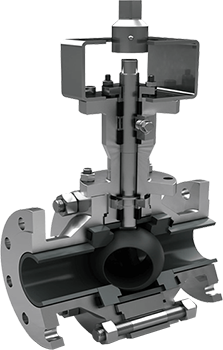Sealing Solutions for High-Temperature Ball Valves
Feb 07, 2025
High-temperature ball valves are crucial control devices in industries such as petroleum, chemical, and power, widely used for controlling the flow of high-temperature media. Due to the unique and complex working environments, the sealing performance of high-temperature ball valves becomes a critical factor affecting their service life, operational stability, and safety. Therefore, a deep understanding of the sealing principles, material selection, and structural design of high-temperature ball valves is key to enhancing their performance and extending their service life.
The sealing performance of high-temperature ball valves primarily relies on metal sealing pairs. Compared to standard ball valves, high-temperature ball valves must endure higher temperatures and more complex working conditions, necessitating more stringent sealing designs. In this context, metal sealing pairs have become the preferred solution in high-temperature ball valve design, offering the following advantages.

The primary advantage of metal sealing pairs is their ability to adapt to a wide temperature range. The small difference in thermal expansion coefficients of metal materials allows them to maintain consistent sealing effectiveness in high-temperature environments. By precisely selecting sealing materials, deformation caused by thermal expansion can be effectively coordinated under extreme temperature differences, ensuring consistent sealing.
Metal sealing pairs can operate stably for extended periods at extremely high temperatures, making them widely applicable in scenarios requiring high-temperature media flow. Compared to other sealing methods, metal seals can better withstand high temperatures and pressures, ensuring the stability of equipment in high-temperature environments.
However, metal sealing pairs also have certain drawbacks, mainly in the following areas:
Due to the high hardness of metal materials, sealing components must endure high specific pressures during operation. Even with preload to achieve sealing, the contact between the valve seat and the ball can still cause significant wear. This wear is particularly pronounced in applications with frequent opening and closing, potentially leading to reduced sealing performance and affecting the long-term stability of the valve.
The high friction coefficient between metal sealing surfaces significantly increases the torque required to open and close the ball valve, necessitating greater force during operation. This not only makes the valve harder to operate but can also cause damage to the sealing surfaces, exacerbating equipment wear.
To overcome the limitations of metal sealing pairs, many high-temperature ball valves employ elastic sealing pairs. Elastic sealing pairs offer stronger elastic compensation and a broader applicable temperature range, effectively addressing the friction and wear issues of metal sealing surfaces in high-temperature environments. The advantages of elastic sealing pairs are as follows:
Elastic sealing materials can automatically adjust sealing performance based on changes in temperature differences, pressure, and wear, maintaining stable sealing effectiveness. Even under high-temperature, high-pressure, and repeated operation conditions, elastic sealing pairs can effectively maintain sealing, extending the service life of the ball valve.
Elastic sealing structures are suitable for both floating and fixed ball valves, making them widely applicable in various high-temperature ball valve designs with high versatility.
Compared to metal sealing pairs, elastic sealing pairs have a lower friction coefficient, reducing the operational torque during the opening and closing of the ball valve. This enhances the valve's operability and reduces wear on the sealing surfaces caused by operational difficulties.
The sealing effectiveness of high-temperature ball valves directly impacts their operational stability, especially in high-temperature environments. The working principle involves achieving sealing through the pressing action between the valve seat and the ball. Under the combined action of preload and fluid pressure, the valve seat material deforms to ensure tight contact between the ball and the valve seat. The quality of the sealing effect depends on the valve seat's ability to effectively compensate for the ball's non-circularity and minor irregularities.
In high-temperature environments, the sealing performance of the valve seat and ball is particularly crucial. High-quality sealing components can effectively resist deformation caused by temperature differences, ensuring the sealing effectiveness between the valve seat and the ball, and guaranteeing reliable valve operation under extreme conditions.
The structural design of high-temperature ball valves must consider not only sealing performance but also the high-temperature resistance of materials and the effects of thermal expansion. Common high-temperature ball valve structures include hard sealing and metal elastic ring sealing.
Hard-sealed high-temperature ball valves typically consist of a valve body, ball, valve stem, metal valve seat, and flexible graphite sealing ring. In this structure, the valve seat is symmetrically embedded into the valve body through the valve stem axis and can slide within the valve body's groove. The sealing between the valve seat and the valve body is achieved through the flexible graphite sealing ring, which has compressible deformation characteristics, ensuring that the valve body does not seize due to ball expansion within a certain temperature range.
Some high-temperature ball valves use metal elastic rings as hard-sealed valve seat sealing rings. Metal elastic rings can effectively compensate for external factors such as temperature differences, pressure, and wear, ensuring that sealing performance is not affected by environmental changes. This structure not only enhances sealing effectiveness but also improves the valve's opening and closing performance. The metal elastic ring can deform when the ball expands due to heat, preventing seizing and ensuring normal valve operation.
As essential industrial equipment, the sealing performance of high-temperature ball valves directly impacts their safety, stability, and service life. Metal sealing pairs, with their wide temperature range adaptability and high-temperature resistance, have become the primary sealing method for high-temperature ball valves. However, they also face issues such as severe wear and high operational torque. By adopting elastic sealing pair structures, these problems can be effectively resolved, enhancing the sealing performance and operational convenience of high-temperature ball valves. Designers must comprehensively consider sealing performance, high-temperature resistance, and operational requirements when selecting sealing methods, choosing the most suitable solution to ensure reliable and stable operation of high-temperature ball valves under various working conditions.
Next: Common Methods for Valve Connection to Pipes
Previous: Wafer and Lug Butterfly Valve: How to Choose?
